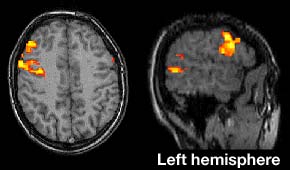How can you communicate if you can't move a muscle? This is the situation for people with 'locked-in syndrome' - but a new study may have a solution.
 For some years, scientists in the field have been working on 'brain-computer interfaces', trying to translate people's thoughts into speech. In the past, this has relied on electroencephalography, using electrodes on the scalp to detect electrical activity in the brain, but a group from the Netherlands has now run a proof-of-concept study using functional magnetic resonance imaging (fMRI).
For some years, scientists in the field have been working on 'brain-computer interfaces', trying to translate people's thoughts into speech. In the past, this has relied on electroencephalography, using electrodes on the scalp to detect electrical activity in the brain, but a group from the Netherlands has now run a proof-of-concept study using functional magnetic resonance imaging (fMRI).
In their study, each letter of the alphabet was assigned a 'mental task' - motor imagery, mental calculation, or inner speech. By varying both the delay before starting the task, and the length of time for which they completed the mental task, the volunteers could encode 26 letters and a space.
By looking at the active areas of the brain during this time, the computer could choose the three most likely letters the participant was trying to communicate - and in this small trial, it chose the correct letter first 82% of the time. This allowed the experimenters to have a two-way conversation with the volunteers in real-time, within a single scanning session - something that would not be possible with previous technologies.
Even more importantly, it required less than fifteen minutes' training to get the program working for each new volunteer, and can be adapted for those who cannot voluntarily move their eyes - making it suitable for people suffering complete paralysis. This group has been unable to use EEG-based communication systems in the past.
If this can be shown to be successful in patients - rather than healthy volunteers - this could allow the vast majority of locked-in patients the opportunity to communicate with healthcare professionals and their loved ones. It could also make distinguishing between locked-in syndrome and a person in a vegetative state much easier: a single coherent answer using this system would confirm the patient is conscious and aware.
- Previous The Moon's missing water
- Next 'Flu's Hidden Gene









Comments
Add a comment